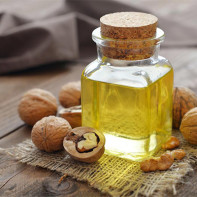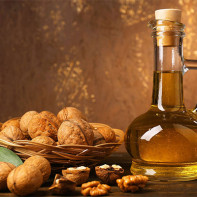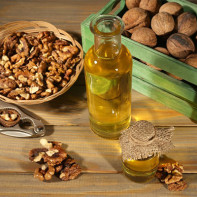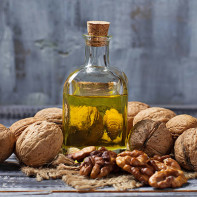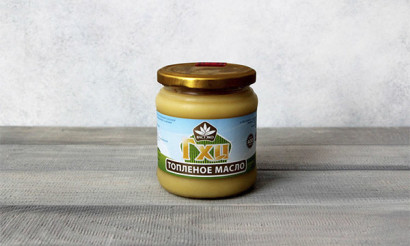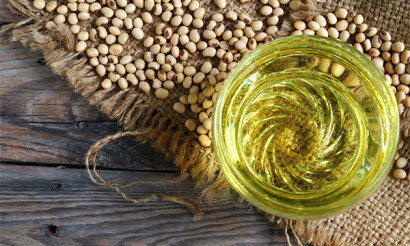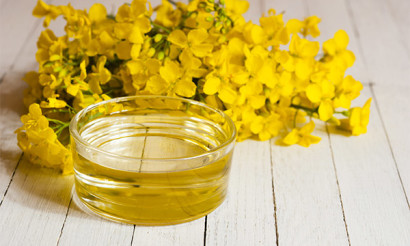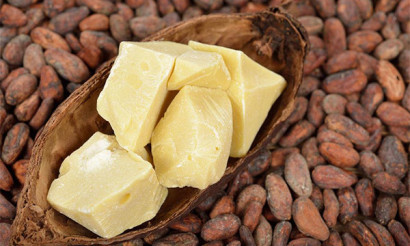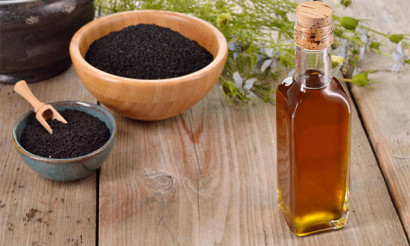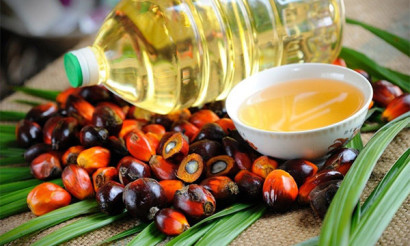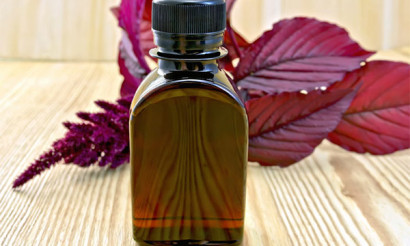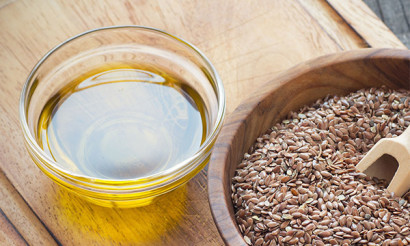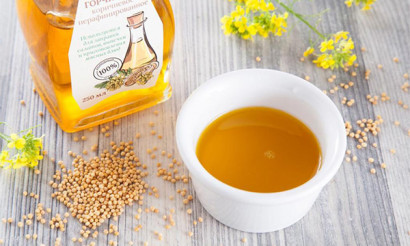Walnut oil: useful properties and contraindications
Walnut is a small-sized fruit in a hard shell. It grows on the tree of the same name, which is considered one of the oldest plants on our planet. The first mention of it researchers find in ancient times. Walnut is a treasure trove of a variety of vitamins. Therefore, the use of products derived from it is very common.
- Composition and calories
- Useful properties of walnut oil
- For Women
- For Men
- In pregnancy
- For breastfeeding
- For children
- When losing weight
- Walnut oil in medicine
- Recipe for healing wounds
- Recipe for increasing efficiency, improve memory and attention
- Recipe for strengthening and elasticity of blood vessels.
- For diabetes
- In pancreatitis
- For constipation
- Walnut oil in cosmetology
- For Face
- For hair
- For Tanning
- Cooking Usage
- Can I fry in walnut oil?
- Hazards and contraindications
- How to choose and store the walnut oil
- How to take walnut oil
- Inside
- Outside use
- How to make walnut oil
- Factory
- Home production
- Interesting facts about walnuts
The kernel of such a plant contains a diverse range of micro- and macronutrients, making this food product unique. The most useful properties conceals the cold-pressed oil from the walnut kernel.
Composition and calories
The rich composition of the vegetable oil has found wide application in medicine, cooking and cosmetology.
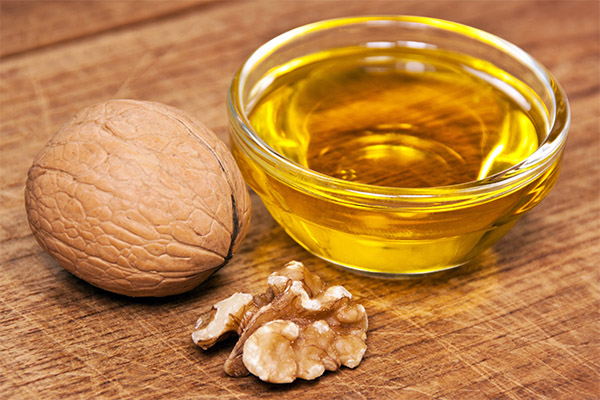
The caloric value of the walnut ester is high, with a maximum fat content, and is about 45% of the daily dose required for a person per day. 100 g of the ready-to-eat product contains 880.2 kcal. Protein - about 0.6 g, fat - 99 g, and carbohydrates - less than 0.4 g.
The chemical composition of walnut oil is very diverse:
Vitamins, mg (in 100 g)
- B6 pyridoxine hydrochloride (0.54). Helps proper metabolism. Several times reduces the risk of blocked blood vessels and arteries.
- B9 folic acid (0.008). Takes part in the formation of connections of proteins, fats and carbohydrates. Normalizes processes in the digestive tract. Prevents miscarriages. Participates in the formation of the neural tube of the fetus. Improves immunity. Synthesizes hormone of joy, improving mental well-being.
- B4 choline (0.21). Improves mental ability, memory, attention. Participates in repairing liver cells and forming nerve endings. Reduces the risk of diabetes, cholecystitis and pancreatitis. Increases sperm motility.
- K phylloquinone (0.015). A fat-soluble vitamin responsible for the body's metabolic processes. It participates in the synthesis of proteins, while guaranteeing the necessary coagulation of human blood. Phylloquinone in walnut oil helps the absorption of vitamin D and calcium. It helps relieve cramps.
- E alpha-tocopherol (0.71). Helps body cells stay in shape, prevents thrombosis. Keeps the heart muscle working properly, improves potency, and normalizes the cycle in women. Tocopherol in walnut oil is a natural oxidant that protects human arteries and fights tumor growths.
- Vitamin A (0.0021). A retinoid responsible for the human nervous system, vision and skin, teeth and joints. Vitamin A in the walnut oil helps to improve the defenses and strengthen the body as an adult and child.
Minerals, mg
- Zinc (3.1). Participates in the renewal of skin cells, helps to heal wounds, burns, cuts, improves immunity.
- Calcium (98.8). Improves dental and bone health, lowers cholesterol, strengthens cells throughout the body.
- Phosphorus (345.9). Ensures healthy growth and further proper development of human teeth and bones.
- Potassium (440). Participates in maintaining intracellular pressure by balancing with sodium. Helps proper development and function of the kidneys, heart, and brain.
- Magnesium (159). Relieves headaches, stabilizes brain function, and reduces the risk of heart as well as vascular disease.
Fatty acids, mg
- Omega-6 or lenioleic acid (52.9). It is responsible for the proper functioning of the cells of the human body. Improves cell membrane membranes, increasing the body's resistance to adverse environmental factors. Facilitates the elimination of toxins. Improves heart and lung function, hair and nail growth.
- Omega-3 or linolenic acid (10.4). Normalizes the balance of fats by participating in the process of cholesterol metabolism. Prevention of atherosclerosis, strokes, and heart attacks.
- Omega-9 or oleic acid (22.64). The main source of energy. Increases the elasticity of blood vessels. Helps in the absorption of various vitamins.
- Stearic acid (2). Has protective and regenerating properties for the skin.
- Palmitic acid (0.1). Improves the synthesis of elastin, collagen and hyaluronic acid, promoting renewal and healing of skin tissue.
It also contains coenzyme Q10 (ubiquinone) - a natural antioxidant and immunomodulator that slows down the aging process. Phytosterol lowers cholesterol levels.
Useful properties of walnut oil
In ancient times, walnut and products made from it were considered very useful for most human systems and organs. Herodotus claimed that it gives a lot of strength, both physical and mental.

Walnut oil is rare. It is one of the most unique vegetable oils with unique health benefits. Its use is widespread in different countries and all kinds of spheres of human life.
For women
The use of walnut oil has a beneficial effect on the body as a young woman and a lady of advanced age. This is due primarily to the rejuvenating properties of the product and the presence of antioxidants in its composition.
- According to studies, it is claimed that women whose diet contained walnut oil, look a few years younger than their calendar age. They are less likely to get sick or depressed.
- In addition, the components of oil (folic acid, vitamins K and B4) are involved in the proper formation of the neural tube of the fetus and the development of its circulatory system.
- Vitamins K, E, B9, calcium, magnesium and potassium increase lactation and prevent the development of breast cancer.
- Phylloquinone enables recovery from childbirth by improving blood clotting, preventing large losses of blood.
- Iron and vitamin B9 in the composition of vegetable oil are the preventive components of iron deficiency anemia.
- The complex of vitamin and mineral components of the product improves a woman's skin, strengthens and heals her hair.
For men
It is no less important to consume oil rich in fatty acids, and men. Avicenna discovered the life-giving power of this product for the stronger half of mankind. This is due to the presence in the product of zinc, magnesium and potassium, which are part of the hormone testosterone. This hormone is responsible for both potency and the acceleration of sperm movement. In addition, the healing and anti-inflammatory components of the product reduce the risk of urogenital infections in men and improve potency.
Walnut oil reduces the toxic reactions of the body when using tobacco and alcohol.
When pregnant.
Although the components of walnut oil can relieve spasms, have an anti-inflammatory effect, improve metabolic processes in the body of a pregnant woman, it is recommended to use it only in the first trimester. It is during this period that the product may help in the formation of the nervous and circulatory systems of the future child, and also reduce the risk of miscarriage.
In the 2nd and 3rd trimester, the oil is recommended to be consumed only a few drops a day. Plus you should pay attention to the high caloric content of the product. This is extremely undesirable for a pregnant woman.
When breastfeeding
Walnut oil can increase lactation by several times. Therefore, it is always recommended to breastfeeding mothers. But you should be careful in taking such a supplement, as it is highly allergenic. In this case, allergies can manifest themselves after a few weeks (cumulative nature). It is not recommended to use vegetable oil and mothers of babies with colic in the intestines and increased gas formation.
In the absence of any reactions to the life-giving product oil, getting into the body of a newborn through breast milk, will strengthen its immunity, optimize the circulatory system, increase hemoglobin and improve mood.
Apply the oil during breastfeeding can also be used externally, rubbing into cracked nipples.
For kids
- Vegetable oil of walnut is recommended for children with weak immunity, brittle hair and teeth, underdeveloped vision.
- Application of this product is recommended by pediatric gastroenterologists for prevention and treatment of constipation, colitis and dysbacteriosis of various etiologies.
- Pediatricians prescribe the drug to children with poor blood clotting.
When losing weight
Despite its high caloric value, walnut oil is used for weight loss. Extracted from the kernels of the walnut contains in its composition all the necessary elements to improve the metabolic processes in the body.
Inside oil is recommended to take as a dietary supplement 1 tbsp. 20 minutes before a meal, 2 times a day. This activates the metabolic, fat-burning processes in the body, the intestines absorb all the vitamins and minerals of the product. This gives strength and gives vitality to the person on the diet.
The oil can also be added to various dishes in the form of a dressing. The permissible amount is up to 2 tbsp. per day.
Walnut kernel oil is often used externally, for example, for anti-cellulite massage.
Walnut oil in medicine.
Walnut oil is widely used in medicine.

Abdominal organs, digestive tract:
- restores liver cells;
- Promotes healing of stomach and intestinal ulcers;
- Improves bile secretion;
- cleanses the bile ducts;
- Reduces acidity of the stomach.
Heart, blood vessels and blood:
- Reduces a person's risk of strokes and heart attacks;
- strengthens the walls of blood vessels;
- increases blood clotting;
- lowers cholesterol;
- normalizes blood pressure;
- Participates in the process of hematopoiesis.
Nervous system and brain:
- improves memory and attention;
- normalizes sleep processes;
- Increases the elasticity of blood vessels of the brain;
- calms;
- Improves performance.
Pelvic organs and kidneys:
- strengthens the walls of the renal pelvis;
- Removes excess fluid;
- reduces cramps during menstruation;
- Improves sperm velocity;
- strengthens the prostate.
The chemical composition of walnut oil also helps fight cancer and is indispensable in the treatment of tuberculosis. Regenerating properties of the product have found use in burn centers and dermatology.
Recipe for healing wounds
Mix in a bowl 1 tbsp. of liquid honey (to melt in a water bath beforehand if you use sugar honey) and 3 tbsp. of vegetable oil. Soak a cotton pad in the mixture and simply place it on the damaged area. The honey will disinfect the wound, and the oil will help rapid healing.
Recipe for Improved Working Ability, Memory and Attention
Mix in equal proportions of walnut oil, hazelnut oil and sesame seeds, add thick honey. Stir the mixture. You should get a thick mass of sweetish flavor. Take 1 tsp. before going to bed.
Recipe for strengthening and elasticity of blood vessels
3 tbsp. walnut essence + 3 tbsp. tincture of immortelle + 3 tbsp. decoction of the dandelion root. Take a solution of 1 tbsp. 3 times a day.
Diabetes mellitus
The common use of preparations based on walnut oil and pure remedy in the treatment of endocrine disorders, including diabetes mellitus. The high content of omega acids and vitamin E make this product essential for people suffering from this disease. Its content of zinc and magnesium helps to normalize blood sugar levels in humans. The glycemic index of walnut oil is 14, which allows it to be used both in the diet and in the treatment of the disease.
It is recommended to take 1 tbsp. oil before going to bed.
In pancreatitis
Unlike walnuts themselves, which are forbidden to eat in chronic and acute pancreatitis, the oil from this fruit is recommended to treat the disease.
- it improves metabolism, speeds up the exit of bile, making the ducts elastic;
- the oil relieves inflammation of the pancreas;
- vitamins, minerals and coenzyme allow the patient to recover faster.
In this disease, medics recommend consuming the oil 3 times a day for half an hour before meals.
To treat pancreatitis, prepare the following solution: 1 tbsp. walnut oil, 2 tbsp. decoction of chamomile, 1 tbsp. decoction of peppermint. The solution heated in a water bath, without bringing it to a boil. Cool and take on an empty stomach in the morning and before going to bed.
When constipation
This is an indispensable remedy to combat a delicate problem. Walnut oil envelops the walls of the intestine, making them elastic and resilient, which improves its peristalsis. Therefore, it is recommended to use it 1 tsp. on an empty stomach in the morning, 1 hour before a meal, until the process is restored.
Walnut oil in cosmetology
One of the most common in cosmetology is exactly the walnut oil. This is due to its high content of non-fatty acids and coenzyme Q10, which have healing and rejuvenating effects.
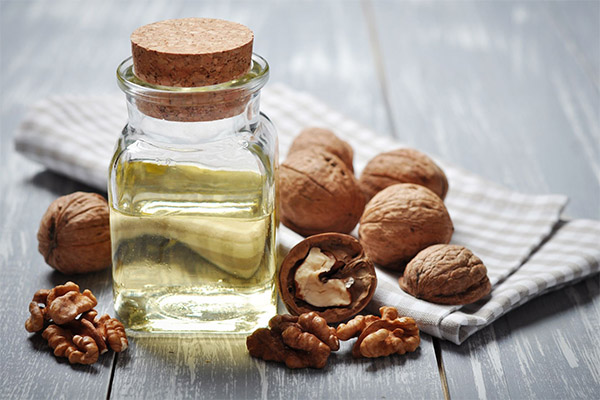
For Face
Moisturizing, nourishing and toning the skin occurs after the application of masks, which are based on walnut oil. It helps to moisturize the face, while saturating it with vitamins that are well absorbed inside.
- Recipe 1. After an evening wash, put a few drops of the oil on a dry face with a cotton pad and gently rub it into the skin in a massaging motion. Leave it on for 5 minutes. Rinse with warm water and blot with a towel. This treatment will not only improve the complexion, but also moisturize and heal minor wounds.
- Recipe 2. In 1 tbsp. oil add 5 tbsp. A strong decoction of chamomile, 5 tablespoons of decoction of oak bark and 1 drop of lemon juice. Moisten the obtained and thoroughly strained solution with cotton pads and spread them on the face, paying attention to the area around the eyes. Leave the mask on for 10-15 minutes. Then wash your face with cold water and blot with a towel. Do the procedure before going to bed once a week. Such a mask smoothes expression lines, evens out skin tone, heals microcracks and gets rid of age spots.
- Recipe 3. Grate two medium cucumbers in a deep bowl, add 2 tsp. of walnut oil to the mixture and mix everything thoroughly. Spread the mush on the face in the form of a mask for 20 minutes. After the time has passed, remove the mixture from the face with cotton disks. Do not wash off. Such a mask will replace a nourishing night cream. Apply it up to 3 times a week.
- Recipe 4. Dilute 3 tablespoons of honey with 3 tablespoons of walnut oil. Steam the face. With a wooden spatula apply the mixture in a thin layer on the face. Leave on for 30-40 minutes. Rinse with warm running water. Blot with a soft towel. Such a mask will deeply moisturize the skin, relieve inflammation, improve its color and elasticity. Rejuvenating effect will be visible after the first use of the mask. Use once in two weeks.
- Recipe 5. Mix 1 tsp. of ginger pulp, 1 tbsp. of walnut essence and 3 tbsp. of cucumber juice in a non-metallic bowl. Use the solution as a moisturizing tonic, apply lightly, as if wiping the skin of the face. Use this recipe can be used once a month.
For hair
Mask with walnut oil helps to strengthen and regenerate damaged hair. They are best for very dry and brittle hair. Oil masks relieve inflammation of the scalp and hair follicles, heal wounds and get rid of dandruff. And fatty acids give strength and shine to any hair type.
- Recipe 1. Before each washing of the head intensely rub the walnut oil into the skin in a circular motion, leaving such a mask for 10-15 minutes, wrapping the head with a towel, creating a greenhouse effect. After that, rinse the oil with warm water and wash your head as usual. You may need to repeat the washing procedure a second time. Such a mask activates hair growth, healing and moisturizing the scalp, thus getting rid of dandruff.
- Recipe 2. In a deep cup add 1 tbsp. walnut oil and 5 tbsp. cucumber juice and add honey. Heat the resulting mixture in a water bath, without bringing it to a boil. In the solution add 1 tbsp. shampoo. Apply the mixture to the hair, wrap it in cling film and a towel and leave for 30 minutes. Rinse the mask and wash your hair the usual way. This nutrition for the hair and scalp will have a beneficial effect on strengthening hair follicles, relieve itching and inflammation of problem areas, and protect the hair from drying out.
- Recipe 3. Mix the oil with shampoo. Wash your hair with this mixture daily for a week. This procedure will strengthen the hair, create a protective film, get rid of split ends and protect from UV rays. In addition, the curls will become more obedient and shiny.
For a suntan.
Cosmetologists recommend applying walnut oil before sunbathing to evenly tan and to keep it in place until fall. Using the oil in a tanning bed or on a beach activates the secretion of melanin, making the skin darker and getting a bronze shade. In addition, such a cream will protect the skin from overheating and burning, moisturize it, nourish it with vitamins and minerals.
- Recipe for tanning. To get a bright suntan during the vacation in 5 tbsp. add 1 drop of tea tree oil, 1 drop of lavender oil and tea rose oil. This sunscreen should be applied without using cotton or gauze disks. So the preparation will lie evenly, without overloading the skin.
- Recipe after tanning. To soothe and cool the skin after sunbathing, mix walnut oil with 2 drops of orange juice, cool it down and then apply. After 30 minutes, take a contrast shower without the use of soaps or gels.
Cooking Applications
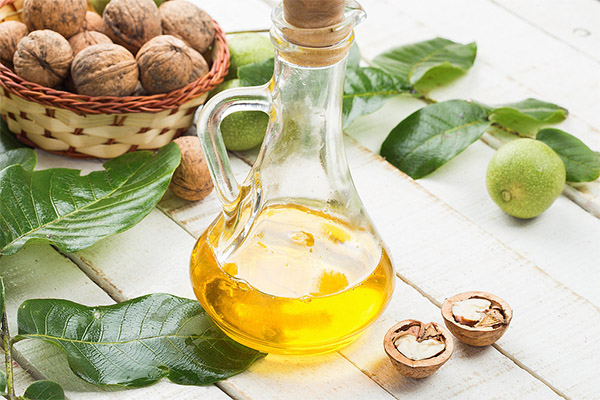
Walnut oil is used in the culinary traditions of the countries where the plant grows. These are the Balkan Peninsula, the Mediterranean. Eastern and Caucasian cuisines also use it very often:
- in salads and cold appetizers;
- dressings and cold sauces for pasta or pizza;
- marinades for poultry and fish;
- Pies and cakes.
Among the most famous dishes using walnut oil are Caucasian mamaliga, French vinaigrette, Italian pizza with arugula and walnut oil, Neapolitan walnut pasta, and Georgian salad with green beans.
We should not forget that the walnut flavor in the oil is quite pronounced, so when adding it to dishes, it is worth observing the proportions, so that the taste of the main product does not disappear.
Is it possible to fry in walnut oil
It is important to note that when heated, walnut oil acquires a bitter taste, and the nutritional properties of the product deteriorate as well. Therefore, its use for frying is not common.
Some chefs still use a mixture for frying meat and fish, which includes walnut oil.
Hazards and contraindications
Walnut oil has bright healing properties, but there are still contraindications to its use. Neglecting them, you can cause serious harm to your body.
- Individual intolerance. Nuts of any kind can cause allergies. Therefore, you should take the oil with caution, and best of all, gradually, watching the reaction of the body.
- Diseases in acute form are also a contraindication to the use of such a remedy, since the weakened body does not always react adequately to high-calorie products. This is especially true for gastrointestinal ulcers in the acute stage.
- Severe poisoning, nausea and vomiting are contraindications to the use of oil.
- People with high blood clotting should also refrain from taking walnut oil, as phylloquinone in the product increases this function of the circulatory system.
- Elevated temperature of unknown etiology is a reason to refuse to use the product until its occurrence is clarified.
Particular attention should be paid to the therapeutic use of the oil in children of preschool age. Unformed children's body may react unpredictably to the therapeutic properties of the product. Therefore, you should consult with your pediatrician before using it.
How to choose and store the walnut oil
To choose the right walnut oil, you need to check it according to several criteria.
- Color - from light yellow to amber, transparent.
- The smell - a bright nutty smell.
- The consistency - thick, viscous.
- Sediment - a light natural.
- Composition - 100% extraction of walnut kernels.
When choosing a product, you should pay attention to its price. 100 ml of the useful substance costs about 500 rubles. If the price is underpriced, the probability that the product is diluted increases.
The oil can be stored at a temperature no higher than 20 degrees. The container in which it is, should be glass. It is best to store it in a dark place. Shelf life of industrial unrefined walnut oil in closed form - up to 6 months. Self-cooked oil is stored for no more than 3 months.
How to take walnut oil
The uses of walnut oil are varied.
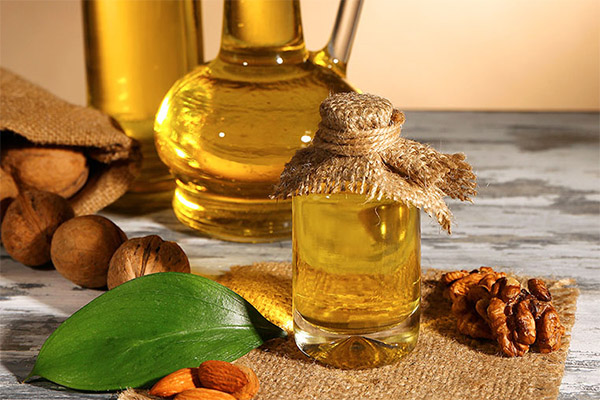
Inside
- Taking this vegetable fat can be done directly through meals by adding it to salads, soups or snacks.
- For preventive and therapeutic purposes, the healing agent should be taken after consultation with a doctor.
- Most commonly, adults are prescribed 1 tsp. half an hour before meals 2 times a day.
- To normalize digestion, the oil is used in the morning on an empty stomach, 1 tbsp.
- To cleanse the liver, kidneys and other organs and systems are prescribed 1 tbsp. oil at bedtime.
Caution is prescribed for children. Since nuts and their derivatives are highly allergenic products, you should start taking 1 drop after breakfast. Gradually increase the dose to 3 drops 2-3 times a day (in the absence of allergic reactions).
Children under 5 years of age can take up to 5 drops before bedtime, from 5 to 10 - 10 drops, older than 10 years - 1 teaspoon before bedtime.
Exterior use
The oil is rubbed into damaged, dry skin lightly, do not wash off.
Like many drugs, walnut oil should be taken in courses, with intervals.
One of the most common therapeutic regimen of this product looks like this.
Monthly intake:
- 1 week - 1 tbsp. on an empty stomach in the morning.
- 2 Week - 1 tsp. 3 times a day for 30 minutes before a meal.
- 3 weeks - 1 tsp. 4 times a day for 30 minutes before a meal.
- Week 4 - 1 tbsp. 2 hours before going to bed.
Then there is a 1-month break, after which you can repeat the course again. In a year you can use no more than 4 courses.
How to make walnut oil
Walnut oil is quite a rare product, and also very expensive. But it can be prepared in different ways.
In the production of
Cold-pressing
Mostly manufacturers of walnut oil use a press. In this case, the walnut kernels are cleaned from the shell and not processed in any other way. They are squeezed out of them. This is how you get unrefined cold-pressed oil. It is the most useful, since it is not heated and does not lose its useful properties.
In Mediterranean countries where walnut trees are grown in whole orchards, they produce "eco" walnut oil using special wooden mortar presses. Such production helps to get the highest grade oil, as each drop of the unique product comes into contact only with the wood.
Modern mass production uses metal presses, so there is some oxidation of the product during squeezing, which reduces the shelf life of the product.
Hot-pressing
In some cases, to give a caramel nutty flavor to the oil, the kernels are roasted and only then put under the press, squeezing the useful and nutritious product. This method is called hot-pressing and is used quite rarely.
Home production
Several variants of walnut oil can also be made at home.
The most common of them is the preliminary grinding of the kernels on a meat grinder, and then in a blender to a fine substance. A few spoonfuls of vegetable oil are added to the resulting mass, wrapped in 3 layers of gauze, and the homemade walnut potion is squeezed. The resulting oil is stored for no more than 3 months in a dark place.
Some housewives make a creamy nut butter. Kernels chopped in a blender are mixed with butter. The resulting mixture is whipped for about 15 minutes at medium speed, producing a fluffy, pasty product. It is added to toppings for tartlets, sauces for meat, and creams for cakes.
Interesting facts about walnuts
Walnuts are unique not only for their nutritional content, but also for their historical facts and legends.
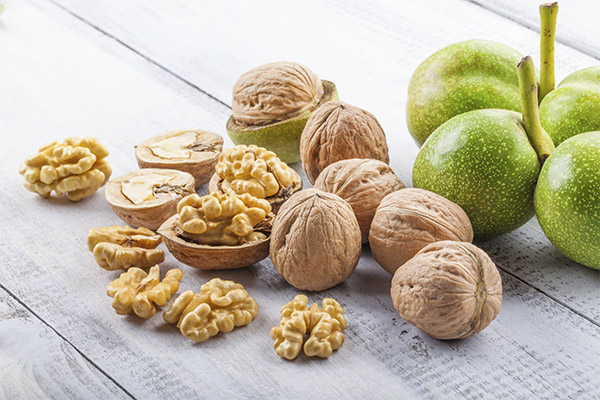
Walnut.
Many botanists refer to the walnut as the "Volosh nut." The history of this nickname goes back to the Romance peoples who called it "volosh." Some sources claim that the oldest finds of this plant were found exactly in the possessions of the Volohs. Hence the name - Volosh nut.
Not a walnut
Many people make the mistake of thinking the walnut is a walnut. In fact, it is a tough globular bone (knuckle) with several septa and a kernel inside.
Not from Greece
One of the erroneous claims is that the name "walnut" came precisely because of the historical homeland of this plant - Greece. This is absolutely not true. Historians point to the Persian origin, although archaeologists note that traces of the walnut have been found in both India and China.
The Greeks themselves called the kernels the Persian walnut, and the Persians, believing in their magical power, nicknamed the kernels the royal walnut. But the name "Greek nut" originated in Italy, when it was the Greeks who brought this fruit to the Mediterranean country.
In Russia, the word "Greek" did not catch on. It was shortened to the convenient "walnut". This is the name of the nut and began to spread.
The legend of Caria
Many researchers associate the name "walnut" with the legends of Greece. There is a belief that the walnut tree is the lover of the god Dionysus, the daughter of the king of Laconia, who died. Dionysus, who was in love and heartbroken, turned her into a tree. Since then, the word "brown" has been used by the ancient Greeks to refer to "walnut" or "hazel". This tree was considered a sacred protector.
Amazing Properties
In ancient times, more than 8000 years ago (the approximate date of origin of the walnut), ancient people learned about the unique properties of this plant. In ancient Persia, the walnut was called "royal". It could be eaten only by kings. Thanks to its beneficial effect on the brain, it got rid of headaches, added strength, helped to recover quickly after illness, and concentrated. Eating such a product was by no means allowed for servants, lest they become smarter and arrange a coup.
"Sacred" plant
Nowadays, the inhabitants of the Caucasus consider the walnut a sacred tree. In the cities and auls you can see trees that are more than 400 years old.
It is believed that the walnut is the oldest cultivated plant.
Thus, it is safe to say that walnut kernel oil has a whole spectrum of healing properties. Its use in various spheres of human life is justified by its nutritional and regenerating characteristics. But we should not forget that any food additive can cause great harm if used improperly. Before using the product, you should consult a specialist.
«Important: All information on this site is provided for informational purposes only Please consult your health care professional before using any of the products. Consult a health care professional before applying any recommendations. health care professional before using any recommendations. Neither the editors nor the authors shall be liable for any possible harm caused by materials."

